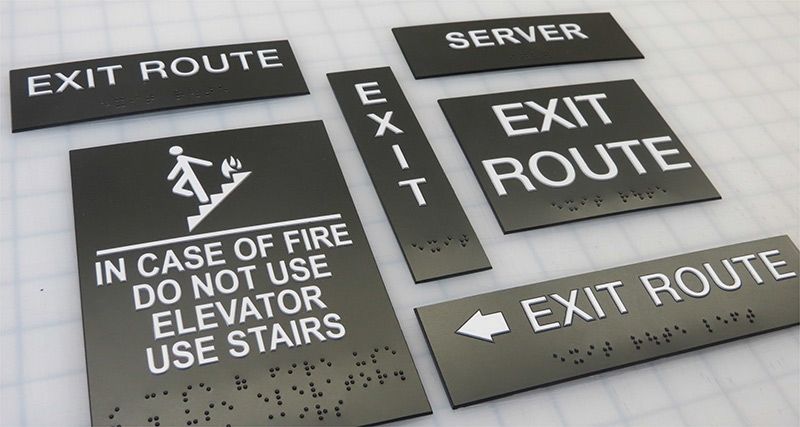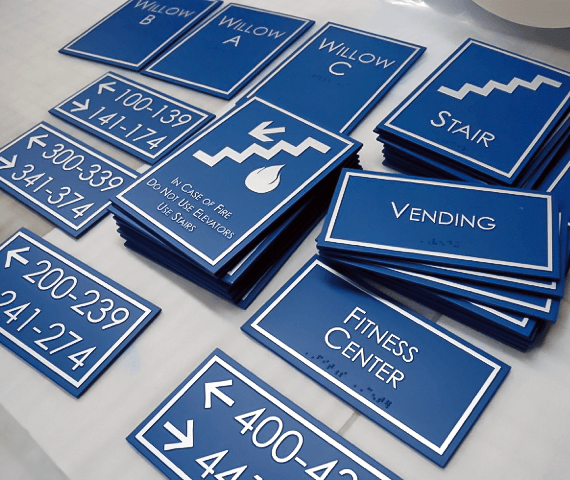Exploring Creative Layouts for Efficient ADA Signs
Exploring Creative Layouts for Efficient ADA Signs
Blog Article
Checking Out the Key Functions of ADA Indicators for Boosted Accessibility
In the world of ease of access, ADA signs function as quiet yet powerful allies, making certain that rooms are comprehensive and navigable for individuals with impairments. By incorporating Braille and tactile aspects, these indications damage obstacles for the aesthetically damaged, while high-contrast color design and understandable font styles provide to varied aesthetic requirements. Their calculated placement is not arbitrary but rather a computed initiative to facilitate smooth navigation. Past these attributes lies a much deeper narrative regarding the development of inclusivity and the ongoing dedication to creating equitable spaces. What much more could these indications represent in our pursuit of universal access?
Value of ADA Conformity
Guaranteeing conformity with the Americans with Disabilities Act (ADA) is important for promoting inclusivity and equivalent accessibility in public areas and workplaces. The ADA, established in 1990, mandates that all public centers, employers, and transport services fit individuals with specials needs, guaranteeing they enjoy the exact same rights and opportunities as others. Conformity with ADA requirements not just meets legal responsibilities yet likewise improves an organization's credibility by showing its commitment to variety and inclusivity.
Among the crucial facets of ADA conformity is the implementation of available signage. ADA indicators are made to ensure that people with specials needs can easily navigate with structures and spaces. These indications have to stick to specific standards relating to dimension, font style, color comparison, and placement to assure exposure and readability for all. Appropriately applied ADA signs assists get rid of obstacles that people with impairments often experience, thus promoting their self-reliance and self-confidence (ADA Signs).
In addition, adhering to ADA policies can alleviate the danger of legal consequences and possible fines. Organizations that stop working to follow ADA guidelines may face fines or legal actions, which can be both economically troublesome and destructive to their public image. Hence, ADA conformity is essential to promoting a fair environment for everyone.
Braille and Tactile Elements
The incorporation of Braille and tactile aspects right into ADA signs embodies the principles of ease of access and inclusivity. It is normally placed below the matching message on signs to make certain that people can access the information without visual support.
Responsive components extend beyond Braille and consist of increased symbols and personalities. These parts are made to be noticeable by touch, enabling individuals to identify area numbers, washrooms, departures, and various other critical locations. The ADA establishes specific guidelines relating to the size, spacing, and positioning of these tactile elements to maximize readability and make certain consistency across various atmospheres.

High-Contrast Color Design
High-contrast color pattern play a pivotal duty in improving the presence and readability of ADA signage for people with visual impairments. These plans are important as they take full advantage of the difference in light reflectance in between message and background, ensuring that indications are easily noticeable, even from a distance. The Americans with Disabilities Act (ADA) mandates making use of certain color contrasts to fit those with limited vision, making it a critical element of conformity.
The effectiveness of high-contrast shades hinges on their capacity to stand apart in numerous illumination problems, including poorly lit environments and areas with glare. Normally, dark message on a light history or light text on a dark history is employed to accomplish optimum contrast. For circumstances, black message on a white or yellow history gives a stark visual distinction that helps in quick recognition and comprehension.

Legible Fonts and Text Size
When taking into consideration the design of ADA signage, the selection of legible font styles and ideal text size can not be overstated. These components are crucial for guaranteeing that indications are obtainable to people with aesthetic problems. The Americans with Disabilities Act (ADA) mandates that fonts need to be not italic and sans-serif, oblique, manuscript, extremely ornamental, or of uncommon kind. These needs aid make sure that the text is quickly legible from a distance and that the personalities are distinguishable to varied audiences.
The dimension of the message additionally plays a crucial duty in availability. According to ADA guidelines, the minimum message height should be 5/8 inch, and it should raise proportionally with checking out distance. This is specifically crucial in public spaces where signage needs to be checked out rapidly and accurately. Uniformity in text dimension adds to a cohesive aesthetic experience, aiding people in navigating environments effectively.
Furthermore, spacing in between letters and lines is indispensable to clarity. Ample spacing stops personalities from appearing crowded, boosting readability. By adhering to these requirements, designers can substantially boost ease of access, ensuring that signs serves its desired function for all people, regardless of their visual abilities.
Effective Placement Methods
Strategic placement of ADA signage is crucial for maximizing availability and making certain compliance with legal requirements. Effectively positioned indications assist people with disabilities properly, assisting in navigating in public areas. Key factors to consider consist of proximity, elevation, here are the findings and exposure. ADA guidelines state that indications should be installed at an elevation in between 48 to 60 inches from the ground to ensure they are within the line of sight for both standing and seated people. This typical height range is crucial for inclusivity, enabling wheelchair customers and people of differing heights to accessibility details easily.
Additionally, indicators have to be positioned beside the latch side of doors to allow very easy recognition before access. This positioning helps people find rooms and rooms without blockage. In cases where there is no door, indicators must be located on the nearest surrounding wall. Consistency in indication placement throughout a center improves predictability, decreasing complication and boosting general customer experience.

Conclusion
ADA indications play a crucial function in promoting availability by integrating functions that deal with the needs of individuals with disabilities. These aspects collectively foster an inclusive setting, emphasizing the relevance of ADA conformity in making sure equal access for all.
In the world of access, ADA indicators serve as silent yet effective allies, making certain that rooms are comprehensive and accessible for individuals with disabilities. The ADA, established in 1990, mandates that all public centers, employers, and transportation solutions fit individuals with disabilities, guaranteeing they take pleasure in the exact same rights and opportunities as others. ADA Signs. ADA indicators are created to guarantee that people with impairments can quickly browse via spaces and buildings. ADA guidelines specify that indicators must be mounted at an elevation between 48 to 60 inches from the ground to guarantee they are within the line of sight for both standing and seated people.ADA signs play a vital function in promoting access by integrating attributes that deal with the demands of individuals with handicaps
Report this page